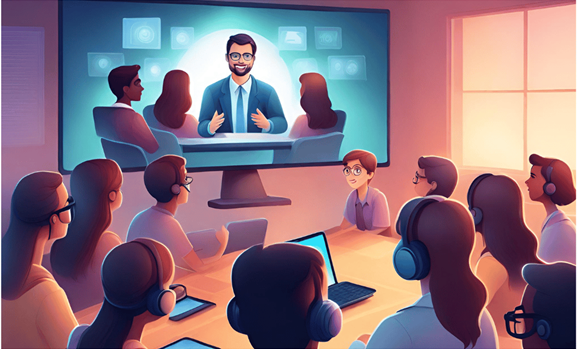
Can Video Conferencing Challenges Be Overcome? Solutions for Audio, Network, and User Issues
Virtual calls and conferencing have solved many problems that we faced in traditional meetings. They have saved us a significant amount of money and time, reducing many hassles that participants would otherwise face. However, does this mean video conferencing has no problems?
While video conferencing has undoubtedly revolutionized communication, it is not without its share of challenges. From technical glitches to issues related to participant engagement, various problems can arise during virtual meetings.
Despite its many advantages, acknowledging and addressing these challenges is crucial for optimizing the effectiveness of virtual communication platforms.
1. Audio quality
Audio quality issues represent a pervasive challenge in the realm of video conferencing, often impacting the overall communication experience.
Several factors contribute to these problems, ranging from technical glitches to environmental disturbances. One prevalent issue is the occurrence of echoes, feedback, or background noise, which can hinder clear communication and lead to misunderstandings.
Sometimes, connectivity problems, such as unstable internet connections or low bandwidth, can result in audio lag, distortions, or even dropped calls.
Addressing this issue requires a combination of technological solutions and user awareness. Participants can optimize their environments by using quality headsets, minimizing background noise, and ensuring a stable internet connection.

2. Too many Apps
A user must download too many video conferencing applications which leads to time consumption and Frustration, as user must keep switching from one app to another depending on where the meeting is scheduled.
One can tackle this problem by installing Meeting room solution at their workplace which allows User to join the meeting without having to download an App in a single click.
3. Network Issues
Network latency, the delay in data transmission, can lead to delays in audio and video synchronization. Participants may experience awkward pauses or find it challenging to maintain natural conversational flow, affecting the meeting’s effectiveness.
Varied device specifications among participants can lead to compatibility issues. Some devices may struggle to handle the demands of video conferencing applications, resulting in performance issues for individual participants.
To mitigate these network-related challenges, it is crucial for participants to ensure a stable and high-speed internet connection. Choosing the right video conferencing platform that is optimized for different network conditions can also contribute to a smoother experience.
4. User Error
Not everyone can be expected to be tech-savvy. Participants might belong to different backgrounds from all around the world.
They may struggle with the basic functionalities of the video conferencing platform, such as joining the meeting, adjusting audio and video settings, or sharing their screen. Lack of familiarity with the interface can lead to delays and interruptions.
Participants may unintentionally introduce background distractions, such as noise from pets, family members, or ambient sounds.
Addressing user errors in video conferences involves a combination of user education, technical support, and etiquette guidelines. Providing participants with training sessions on the platform’s features, encouraging them to test their equipment before the meeting, and promoting best practices for virtual communication can help minimize these errors.
Zoapi addresses this problem by reducing the steps to join a meeting and also provides seamless integration between all the video conferencing equipment.
5. Poor Visual Quality
Poor visual quality in a video conference can significantly impact the effectiveness of communication, leading to frustration and hindering the overall meeting experience. Various factors contribute to subpar visual quality, creating challenges for participants.
Insufficient resolution can result in pixelation, blurriness, and a lack of clarity in video feeds. This often occurs when participants have limited internet bandwidth or are using devices with low-quality cameras.
Poor lighting conditions can impact video quality, making participants appear too dark, too bright, or unevenly lit. Inadequate lighting can diminish the overall visibility of facial expressions and gestures.
Participants can improve their video quality by using high-quality cameras, ensuring proper lighting, and selecting a stable internet connection. As technology advances, efforts to mitigate visual quality issues will contribute to more engaging and productive virtual meetings.
6. Security Worries
Security concerns in a video conference have become increasingly prevalent as virtual communication plays a central role in business, education, and personal interactions.
The risk of unauthorized individuals gaining access to a video conference, commonly known as “Zoom bombing” or similar attacks, poses a significant security threat. Intruders can disrupt the meeting, share inappropriate content, or eavesdrop on sensitive discussions. Sharing meeting links and IDs publicly or without proper safeguards can lead to unauthorized participants joining the session.
Implementing strong authentication methods, such as password protection and two-factor authentication, is crucial for preventing unauthorized access.
Unauthorized recording of video conferences and insecure storage of recorded sessions can lead to data leaks. Organizations must implement secure recording practices and storage solutions to safeguard sensitive information.
In conclusion, while video conferencing has undeniably revolutionized the way we communicate, it is not immune to a host of challenges.
Addressing these challenges requires a multifaceted approach. Users can enhance their experiences by familiarizing themselves with the technology, optimizing their environments, and adhering to best practices. Platform developers must continually refine their systems to improve reliability, security features, and overall performance.
Moreover, maintaining a balance between convenience and security is crucial to fostering trust and ensuring the continued success of video conferencing as a communication tool.
As technology evolves, it is imperative that both users and developers remain vigilant, adapting and implementing solutions to create a virtual meeting environment that is not only efficient and productive but also secure and reliable.
Happy Video Conferencing!




